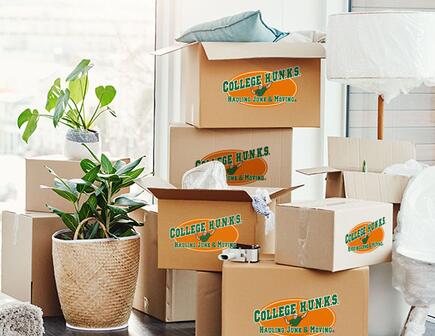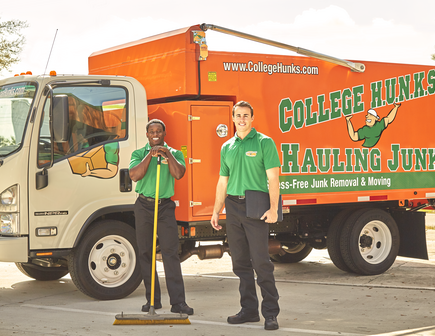
Storage sheds are useful for any number of things, from keeping our things safe during an extended move to housing garden tools and bicycles. They keep everything safe and dry, and more importantly out of the way until we are ready to use them. Unfortunately, they are often the second to last place our unwanted items go before they are either forgotten or hauled off as junk. But even the storage shed itself has a life expectancy. Storage sheds are temporary solutions to your moving problems and though durable, they aren't built to withstand the elements for the length of a house or other building. Over time, sheet metal corrodes, asphalt shingle roofs leak, and over the summers and winters, sunlight and precipitation can reduce a wooden storage shed to a shell of its former self in a short number of years.
Water damage is perhaps the most harmful to a storage shed, as well as impacts from falling trees, vehicles, and even just time itself. Once the physical integrity of a storage shed is compromised, it is no good to anyone. It just becomes part of the “junkscape” of a yard or property. It no longer protects the items that could be kept inside, and other than making stray cats or raccoons happy, you are better off without it. Some are very large and will require some demolition, depending on the size of the truck you can use to haul them off. But it is important to remove them from your site. Not only for aesthetic purposes, but even the liability of having one on your property which might injure someone trying to get inside.
Storage Shed removal
Storage sheds come in a variety of sizes, shapes, building materials, and configurations. None of which are all that easy to remove. Even if they are dilapidated, they are still difficult to break down into manageable pieces. If they are built on a concrete pad, they might even be secured to the foundation.
Special tools or equipment might need to be used to dismantle a storage shed. This is where a full-service junk hauling and removal company is crucial. Not only is proper safety equipment, know-how, and the right kind of truck important to do the job but also there is the question of what happens to the shed once it is removed?
Storage Shed disposal
After the shed is dismantled and loaded onto a truck, the area also has to be cleared. This might include items the storage shed was containing, which are now exposed to the elements. That might require moving them to a new location or simply hauling them off with the rest of the junk. College HUNKS Hauling Junk & Moving partners with local donation partners, Habitat for Humanity, Goodwill, and many other local organizations to make sure that as little of your junk as possible makes it into a landfill. Including the shed itself.
Metal storage shed removal
The metal used to build your shed might have outlived its usefulness for that purpose, but the scrap might find a new purpose somewhere else. Scrap metal can be melted down and made into other things nearly an unlimited number of times. Corrugated steel, tin, or other metals can be repurposed depending on the need, which is something a professional scrap metal company can decide; anything from decorative paneling to metal sculptures. Many of our partners make salvaging scrap metal their business. Scrap metal is a commodity, which is how we can keep our prices competitive, as well as help out the environment. Metal salvaged from scrap metal means less metal mined and processed from raw materials. This reduces carbon emissions, environmental damage from strip mining, and reduction in the use of fossil fuels at forges and foundries.
Wood storage shed removal
Wood storage sheds are similar to metal sheds, with the exception that wood is not as easily recycled as metal. Over time, water damage and the effects of solar radiation on wood cause the fibers to break down, warp, and deteriorate. Insects, varmints, and other animals have an easier time burrowing into a wood storage shed than metal, and accelerate the process of breakdown. Fungus and other plants also work on the structure and render the building materials (and often items inside) rotten and useless over time. The wood can be repurposed, depending on the condition of the structure. Slats and beams in good condition can be repurposed as weathered, "barnwood" type decorations. Wood can be incinerated as well as ground up into mulch, depending on the condition. Shingles can be reused as well. Our partners in recycling and repurposing are experts when it comes to this, which takes a lot of the headache of trying to figure out the best way to remove and dispose of your wood storage sheds.
Better for the environment and better for you
Our practices of eco-friendly disposal of metals recycling, hazardous materials handling, and wood structures are done with the health of our customers in mind; as well as the well-being of the planet. Metals and wood, as well as hazardous materials, do a lot of damage in landfills. Acids, petroleum products, and even the chemical byproducts of wood such as formaldehyde can seep into the soils and groundwater of a landfill. Keeping as much of that as possible out of the environment, and disposing of them safely, is crucial to the community and the environment for generations to come.
How to prepare your shed for disposal
Empty out the shed: Items inside the shed might not be considered junk, and will need to be moved to another area for storage. Our full-service team can help with that as a separate service. Be sure to ask about junk removal and moving services when you speak to a representative.
Disassemble or deconstruct: Most College HUNKS locations offer light demolition as a service if you are unable to safely deconstruct the shed yourself. You can discuss this need with our representatives when you call.
Clear access: Over time, your storage shed might be surrounded by overgrown trees, shrubs, or hedges which would make it difficult for our removal trucks to access the area. Make sure that an adequate pathway has been made to the storage shed before our HUNKS come out to remove the shed. Sheds are usually removed in large sections from the property, in large trucks, so this step is very important. Pets, livestock, or other animals that could impede the job should also be kept out of the area.

Full-service help you need
There are all sorts of reasons for removing a storage shed, but only a handful of ways to do it properly. If you are too busy, lack the tools or desire to do the job yourself, you should consider our full-service help. Speak with a representative to give you an estimate of how much it will cost to get rid of your storage shed. We are experts in removing other junk too, as well as a full-service moving company. Call us to get started with a free, no-obligation estimate today!
